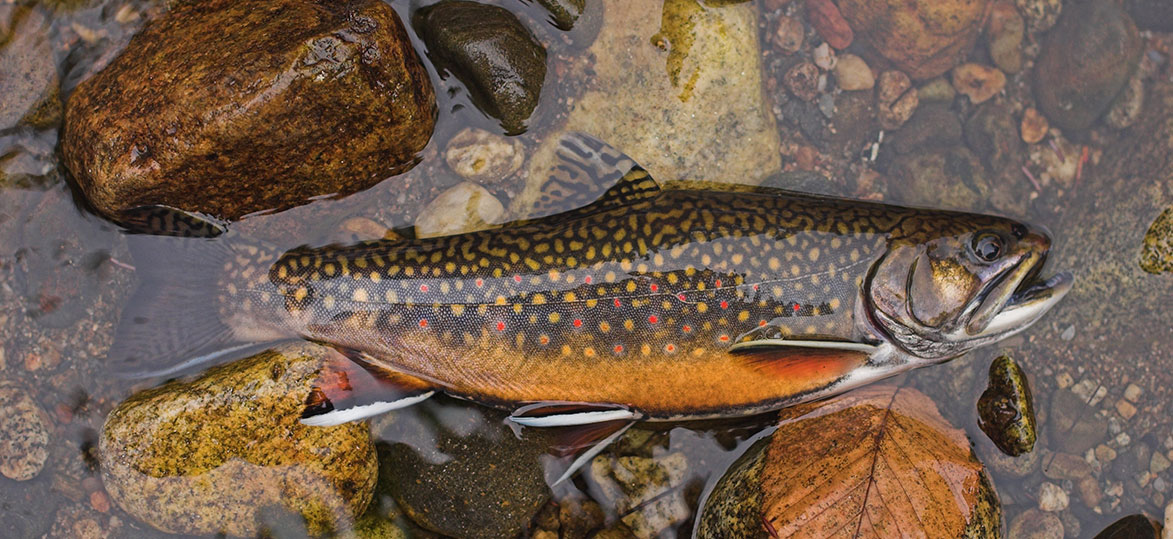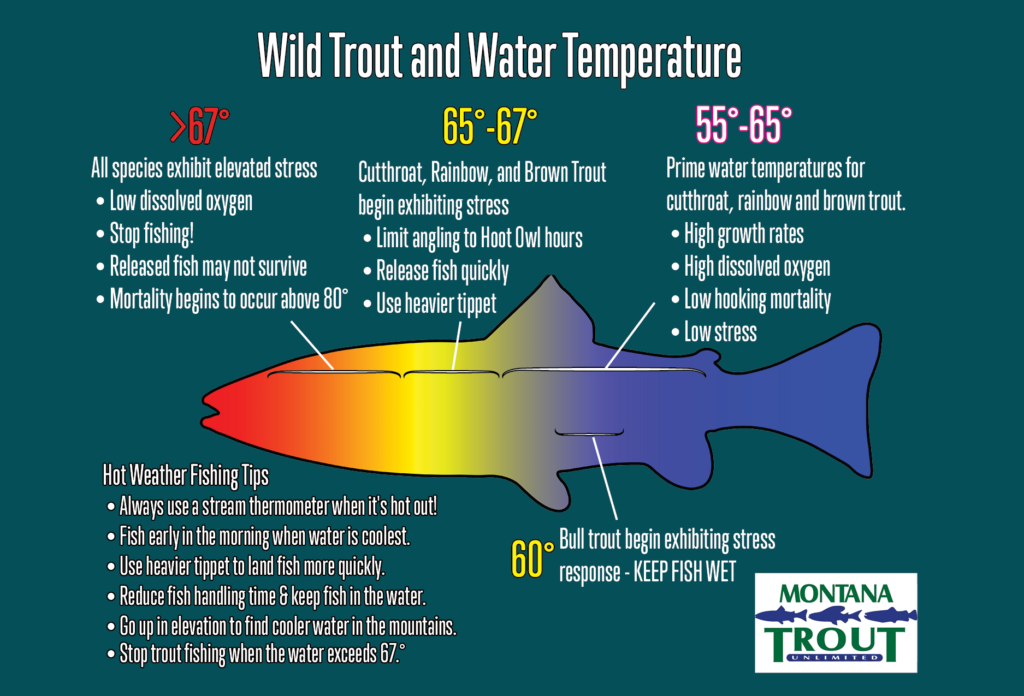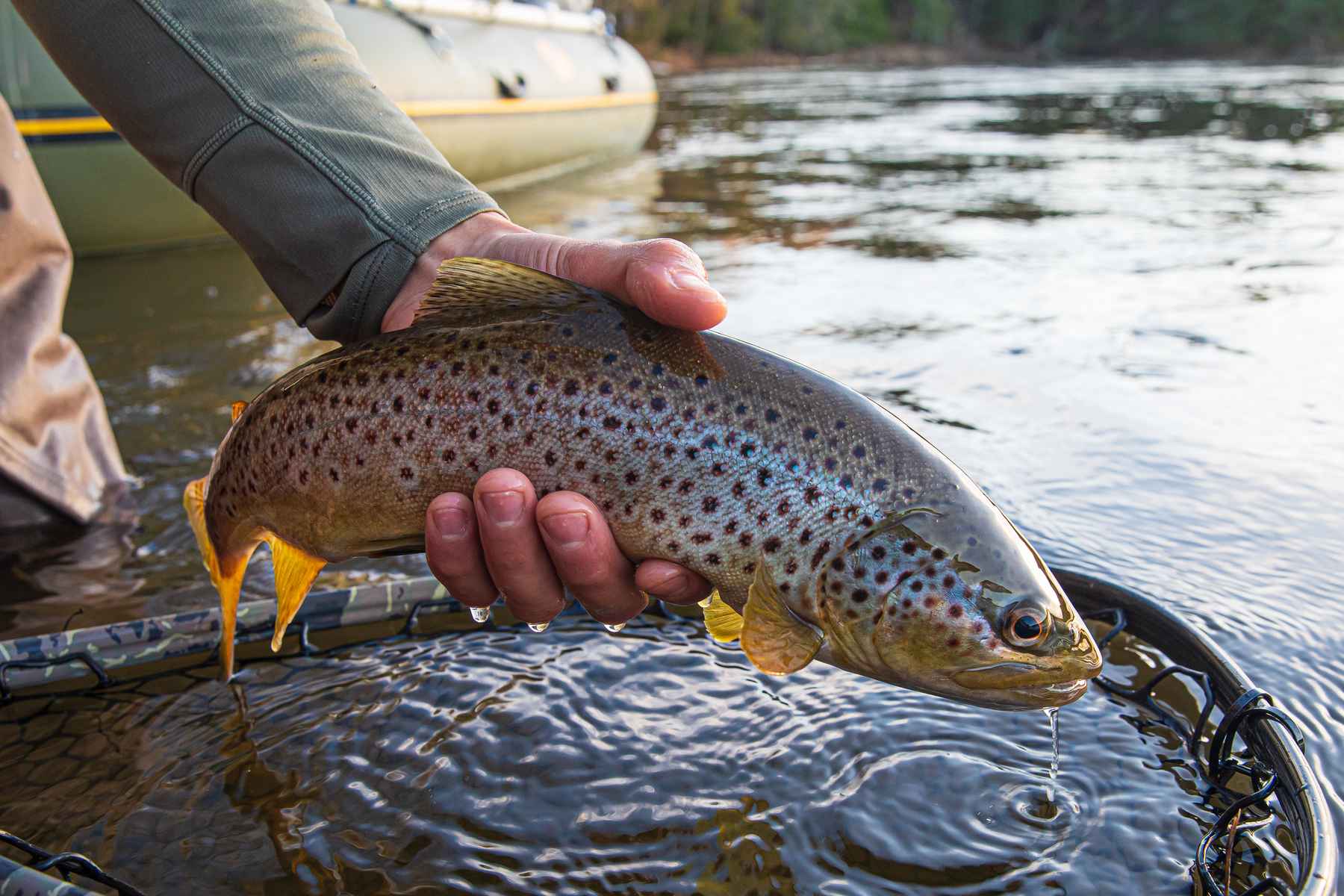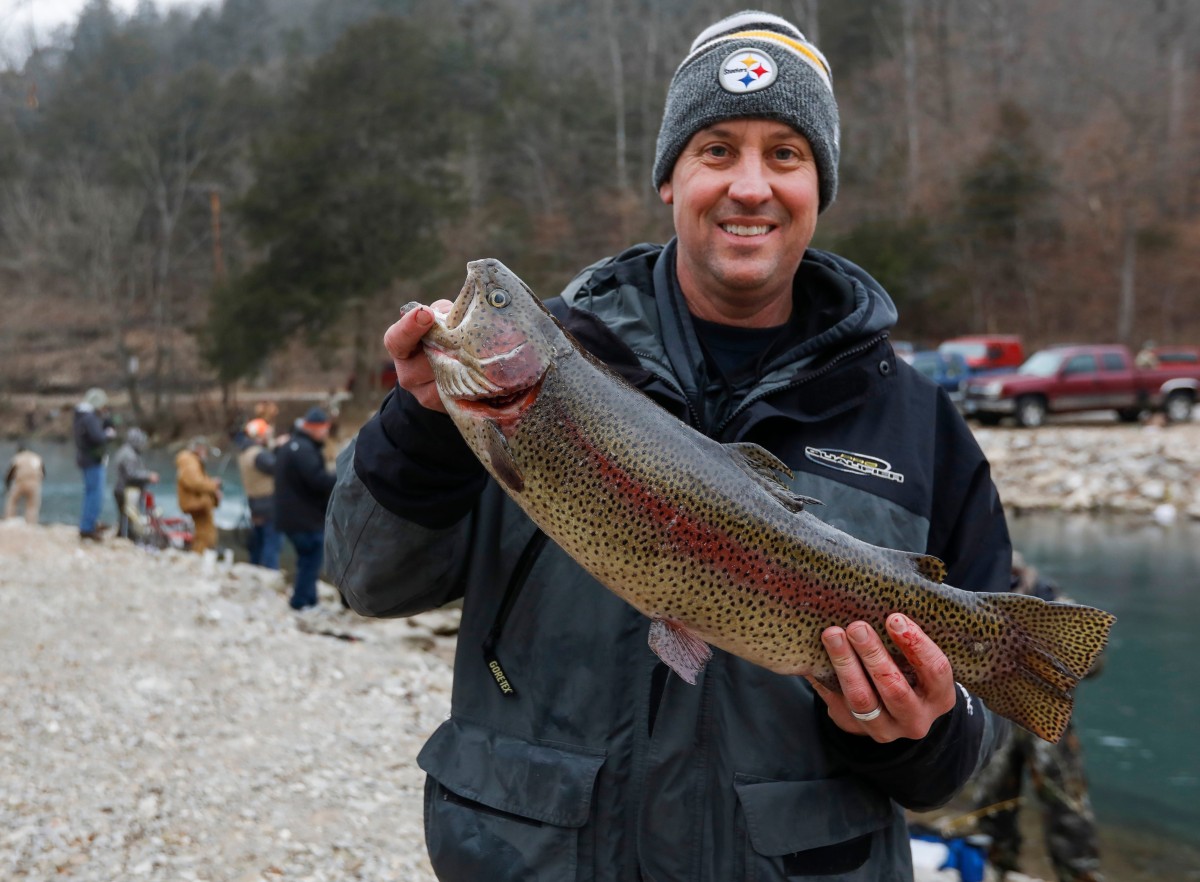Trout are cold-blooded fish that prefer to live & feed in colder H2O around 53°F which holds more dissolved oxygen but as H2O warms, oxygen begins to dissipate, and trout become less active and will move up & down in the water column or to a different location to find colder temperatures.
Trout temperature tolerances vary by species, but not by a lot with Rainbow and Brown being the hardiest they are the most stocked and the most taken on the First Day of Trout Season.
Introduction:
Understanding the intricacies of trout activity and water temperature can greatly improve the success of your fishing endeavors. One such intricacy is the correlation between water temperature and trout activity. In this article, we’ll take a look at the world of trout behavior, shedding light on the optimal water temperatures for these fascinating creatures. We will deep-dive into how temperature changes impact their feeding, spawning, and general activity levels. So, whether you’re a seasoned angler or a curious nature lover, you’re sure to find some valuable knowledge on the unique lifestyle of trout in varying water temperatures.
Understanding Trout Activity: Water Temperature
Many variables go into when Trout is the most active. The most obvious time is in warmer months when the temperatures are starting to climb then early in the morning when the air and water are cooler than the rest of the day. Then late in the day just before dark when the sun goes down for the same reason. When the sun comes up in much warmer temperatures look for signs of insects over a stream even in early spring when a few degrees can make all the difference.
Those slight rises in the warmth will stimulate life meaning smaller insects that are native to the water and the ecosystem. Once you see a few insects flying over the water nature starts to wake up the bugs then the birds then the fish will rise to those thermal layers of warmer water that are exposed to the sun. It doesn’t take long.
Fly-fishermen use the native fly to catch the native Trout that can live in the same waters for up to 20 years. Trout who swim the streams love to feed on insects aquatic life and flies.
In early spring try using insects more towards midday when the sun gets a few hours of solar rays on the water and in later spring when the morning hours are cool enough because the sun hasn’t had the chance to push the temperatures too high for the Trout’s liking.
Trout is kind of funny when the water’s temperature is involved and will eat and stay active as long as the environment is comfortable around them and a stream when the temperature breaks ever so slightly. A few degrees can act as an alarm clock waking up the whole ecosystem including the Trout.
I like These Rules of Thumb for catching Trout
- Rule of thumb: If the air temperature is uncomfortable below freezing or too hot, it will be uncomfortable for the trout as well, since they are cold-blooded and their body temperatures reflect the temperature of the water they swim in. Because Trout are cold-blooded then they like water temperatures of 34 to 67 degrees but will feed in the best temperatures between 44 and 64 degrees.
- Take the temperature of the water and you can physically see it.
- Since Trout don’t have eyelids and can’t dilate their pupils, they must seek shade in the extreme sun to avoid bright lights. So if you can, fish under cloud cover when water temperatures are cooler or look for shady areas where you can quietly walk into the water using waders or hip boots.
- If the water moves above 60 degrees move upstream or deeper into the water column into cooler water
Understanding the behavior of trout, particularly about water temperature, is fundamental to enhancing your fishing experiences. As water temperatures rise, trout become more active. However, this increase in temperature often corresponds with a decrease in dissolved oxygen, triggering changes in trout activity.
Water temperature plays a significant role in trout fishing. Since trout are cold-water species, certain water temperatures are more conducive to their feeding and breeding patterns than others. Finding the optimal water temperatures for trout and fly types can greatly enhance your fishing experience.

Fishing for trout is a favorite pastime for many anglers. The thrill of reeling in a trophy trout as the crisp morning air surrounds you is unparalleled. But it becomes even more rewarding when you understand how the water temperature impacts trout activity. The activity level of trout changes as the water temperature rises. Trout needs water with a high amount of dissolved oxygen to thrive. However, as the water temperature increases, the level of dissolved oxygen decreases, causing trout to become less active.
Degree by degree, as the water temperature rises, trout fishing will reduce their activities to conserve their energy. Fishing during periods of high temperature may result in low catch rates as the trout becomes less active. But, don’t despair! The key is understanding the relationship between trout, water temperature, and the resulting trout activities.
It’s also interesting to note that different trout species have different temperature preferences. Some species prefer cooler water temperatures, while others thrive in slightly warmer waters. Therefore, understanding the specific water temperature preferences of various trout species increases the chances of a spectacular fishing excursion.
Knowledge of how these temperature changes affect trout activity can equip you with the necessary skills to adjust your fishing techniques accordingly.
In trout fishing, knowing the water temperature and how it affects trout activity can prove invaluable. Equipped with this knowledge, you can enjoy rewarding fishing experiences despite fluctuations in water temperature. And the thrill of hooking a trout is even more satisfying when you understand the role water temperature plays in their activity level.
Despite the trout slowing down their activities when the water temperature rises or the dissolved oxygen decreases, it doesn’t mean that you can’t be successful at fishing. Mastering the art of trout fishing is all about understanding trout activity across different water temperatures and adapting your fishing strategies accordingly. You may surprise yourself by reeling in a record-setting trout!
Ultimately, fishing for trout and successfully reeling them in hinges significantly on your understanding of water temperature. Water temperatures affect trout in various ways – everything from their feeding habits to their level of activity. As such, an astute observation of these temperature changes can make a big difference in enhancing your trout fishing adventures.
Keeping a close eye on the water temperature, learning to predict how it impacts your trout fishing activities, and understanding when optimal water temperatures occur can mean the difference between an okay day of fishing and the fishing adventure of a lifetime.
How Do You Tell the Difference Between Trout?
3 primary species of trout:
Brown Trout-brownish-yellow color-scattered black, red,& orange spots on their sides-12″ long or less
Brook Trout-(Speckled trout) brown with reddish fins & white tips-8″ long or less
Rainbow Trout-dark back & white belly-pink stripe down middle-up to 12″ long are common .………………………………………………… Read more
Brown and Brook Trout Water Temperature: A Detailed Guide
If you’re an angler who finds joy in trout fishing, more specifically brown trout and brook trout, then understanding their water temperature requirements is essential. Most anglers are unaware that these fish have optimal water temperatures, which can seriously impact your fishing trip. Here’s a detailed guide on brown trout and brook trout water temperature considerations.
Trout water Activity-Trout Temperature
The brown trout, a remarkable species, tends to be more flexible when it comes to water temperature. They tend to thrive in cooler water yet can sustain life in comparatively warmer water too, which often leaves anglers amazed.
Brook trout, on the other hand, are known for their specific water temperature requirements. A slight variation in the water temp can impact the brook trout’s feeding habits and activity levels. While successfully fishing for brown and brook trout, the temperature guide proves handy, and having a grasp on water temperatures can provide an upper edge.
Be it a river flowing out in the open or a water body nestled amidst the mountains, water temperatures can vary, and so can the activity of the trout. For instance, the water temperature of a river on a scorching summer day can work against your plans of catching trout – brown trout or brook trout.
The Brook trout

Unlike the brown trout, gravitates to distinct temperatures. Any minor deviation from their ideal water temperature might cause them to lay low, affecting your fishing plans. The brown trout, however, tend to adapt more easily, so the brown trout fishing doesn’t get disturbed as often.
Fishing in a river isn’t the same as fishing in a lake or a small pond. The river, with constantly changing currents and temperatures, inevitably causes variations in the trout’s behavior. So, whether you’re fishing for the brown trout, which is more temperature-resilient, or the brook trout that’s a tad temperature-sensitive, being aware of the water temp is a step in the right direction.
Tracking water temperatures makes a significant difference in fishing, especially for trout. Knowing when the water temperature rises or falls allows us to forecast the trout’s behavior – whether they’ll be more or less active. So keep an eye on that water temperature and happy fishing!
The Effect of Lake Trout Activity and Water Temperatures
Lake trout, like most other fish species, are remarkably sensitive to water temperature variances and their activities dramatically fluctuate in response. So, if you’re seeking to catch trout, the time and temperature of the water can make a substantial difference.
Trout are cold-water fish and prefer water temperatures that are ideal for their bodily functions. Water temperature can affect trout activities such as feeding, migration, and spawning.

Of all these activities, feeding is perhaps the most influenced by the water temperature. Lake trout tend to be more active and likely to pursue prey in cooler waters. Hence, a keen angler seeking to catch trout should check the water temperature before casting a line.
For the hobbyist or serious angler, it’s essential to recognize these particulars; not grasping the significance of water temperatures can spell the difference between a fruitful day of fishing or returning home empty-handed.
At certain temperatures, trout become inactive and are less likely to bite, making fishing a less productive activity. Every catch becomes a lesson, and every fishing trip, a way to understand the trout’s behavior better.
So, what is the optimal water temperature for trout? This question is not as straightforward to answer. Various factors like the time of the year, geographical location, and water type, all play integral parts in defining the ideal water temperature for trout. The most resourceful way to enhance your understanding is by checking and keeping a record of the water temperatures each time you fish. Over time, you’ll be able to see patterns and make connections between trout activity and water temperatures.
While each species of trout has slightly different temperature preferences, the optimal temperature range for lake trout typically sits between 50°F and 55°F. When water temperatures rise above this range, trout activity often declines.
Metabolism, digestion, and general functions are limited, and the trout become stressed. Conversely, if the water temperature falls below 50°F, trout will start to lose their vigor and decrease their feeding. Essentially, cold-water fish like trout thrive in temperatures around their optimum thermal preference.
As an angler, knowing how water temperature affects lake trout activity is an invaluable advantage. It’s an integral part of fishing. By checking the water temperature regularly, understanding seasonal patterns, choosing the right time to fish, and aligning these with the trout’s optimal water temperatures, you will dramatically increase your chances of success on your next fishing trip.
By gaining a deep understanding of trout activity and water temperatures, anglers can significantly enhance their fishing experiences. You have to remember, it’s not just about catching trout but learning about and appreciating the nature and behaviors of these magnificent creatures. Knowing the how and why of trout activity under different water temperatures is the key to becoming a successful, experienced angler.
A Comprehensive Trout Temperature Guide Exploring Seasonal Variations
Understanding the influence of water temperatures on trout activity is crucial for successful trout fishing endeavors. A comprehensive trout temperature guide can be instrumental in deciphering the shift in trout behavior during different times of the year. These seasonal variations significantly affect trout feeding patterns, which, in turn, impact the approach you need to take when fishing for trout.
The feeding habits of trout are tightly linked to the water temperature. Trout are cold-water species, and they thrive in specific temperature conditions. Extreme temperatures, both hot and cold, can stress trout, leading them to reduce feeding and sometimes even lead to their death. Thus, a keen understanding of trout water temperature behavior can enhance your trout fishing experience. 
When discussing water temperatures, we have to consider both the surface and bottom temperatures. These temperatures vary wildly with the seasons. For example, October and November can be quite cold, causing trout to go deep into the water where it is warmer.
On the other hand, in February when the sun is out, and the water surface heats up, trout might show up to feed. Paying attention to these details is key to successful trout fishing in different seasons.
The temperature guide can help fishermen determine the best times to fish for different species of trout. Predominant species like brown trout and brook trout have different optimal water temperatures.
By understanding the preferred temperature ranges of these species, you can increase your success in catching them.
This information also assists in preserving the fish population as it promotes fishing during the periods when fish are naturally most active and healthy.
And it’s not just the trout feeding habits that are influenced by changes in the water temperature. The spawning cycle of trout also changes as temperatures fluctuate. Understanding when different trout species spawn can provide an additional benefit. Knowing these patterns will help to prevent unintentional capturing of breeding fish, contributing to long-term sustainability in trout fishing.
By understanding and leveraging the information in a comprehensive trout temperature guide, you can significantly improve your trout fishing experience. Monitoring water temperatures and understanding their seasonal variations have a profound effect on trout activity. By keeping this in mind, you can increase your chances of hooking trout and enjoying a successful fishing adventure.
Here’s a table providing a comprehensive trout temperature guide exploring seasonal variations:
| Season | Temperature Range (Fahrenheit) | Trout Activity |
|---|---|---|
| Winter | 32°F – 50°F | Decreased activity; seek warmer water |
| Spring | 50°F – 60°F | Increased activity; spawning begins |
| Summer | 60°F – 70°F | Peak activity; feed actively |
| Fall | 50°F – 60°F | Activity decreases; prepare for winter |
While many factors contribute to effective trout fishing, understanding the temperature behavior of these amazing species is unquestionably crucial. It doesn’t just make you a better angler; it also makes us all better stewards of these vital ecosystems.
Strategies for Catching Trout in Different Water Temperature
Whether you’re into fly fishing or prefer traditional trout fishing, the right knowledge and gear can place you several strides ahead of your angling peers. And let’s face it, none of us wants to come home empty-handed at the end of the day.

You should be aware that during the heat of the afternoon when water temperatures rise, trout seek cooler, deeper waters to conserve energy. This is the time you might want to consider employing gear like round tungsten or slotted tungsten sinkers to reach those depths. Cool mornings and evenings are often more productive as these are feeding times for trout. Employing fly fishing methods at these times could see your catch rates increase.
However, it’s not as cut-and-dried as it sounds. Water temperatures can fluctuate depending on the time of year, time of day, and specific weather conditions. Trout, being the versatile fish they are, adjust their behavior accordingly. It’s essential to understand these seasonal and diurnal patterns to maximize your trout fishing experience. For example, in hotter summer months, when water temperatures rise above the optimal range, trout fishing can become a real challenge. Fish may feed less and seek refuge in deeper waters.
You may need to adjust your techniques, preferring early morning or late evening times for fishing. In contrast, during the cooler months, when water temperatures fall, trout may become more sluggish and less inclined to chase lures. The belief here is that the trout are trying to conserve their energy. A slower, more deliberate approach may be the key to success. Fishermen should be aware of the technology today. Digital tools can provide valuable data about water temperatures, which can be utilized to foresee and prepare for changes in trout behavior.
So remember, whenever you decide to go trout fishing, check the water temperature first. Truly understanding and adapting to trout activity related to water temperatures will significantly enhance your angling experience, allowing you to successfully catch trout in any condition. Plan today, spend a little time reflecting on some of these strategies and do yourself a favor. Next time you’re gearing up for a day of trout fishing, whether you fly fishing or traditional fishing, keep these tips in mind. We are confident they’ll help you catch trout more consistently. Happy trout fishing!
Conclusion:
In conclusion, understanding trout activity water temperature and the optimal water temperatures is crucial to finding success in trout fishing. Knowing when the trout are most active and their feeding habits in different temperatures will drastically increase fishing success. As water temperatures fluctuate, so does the behavior of trout, making it an essential parameter to look out for when fishing. With this knowledge, you can strategically plan your fishing trips, which optimizes your chances of a big catch. Remember, the essence of angling lies in respecting nature’s rhythm and using it to our advantage.
The amount of Dissolved Oxygen (DO) needed varies for fish species. Bottom feeders-warm water fish (Catfish, Carp) need less oxygen (1-6 mg/L), shallow cold-water fish (Trout & Salmon) need higher levels (4-15 mg/L) some fish adapt to lower levels, Bluegill, Largemouth Bass, Perch for a short time .…………………………………………………………….. Read more

References:
Hatch – Trout and water temperature: How hot is too hot?
FAQ’s
Q: How does water temperature affect trout activity?
A: As water temperatures rise, trout become more active. However, this increase in temperature often corresponds with a decrease in dissolved oxygen, triggering changes in trout activity. Also, as the water temperature increases, trout reduce their activities to conserve their energy.
Q: How can understanding water temperatures enhance my fishing experience?
A: Understanding the behavior of trout, particularly about water temperature, is fundamental to enhancing your fishing experiences. Knowing the water temperature and how it impacts trout activity can help you adjust your fishing techniques to increase your success rate.
Q: What happens to trout activity when the water temperature rises?
A: The activity level of trout changes as the water temperature rises. Trout needs water with a high amount of dissolved oxygen to thrive. However, as the water temperature increases, the level of dissolved oxygen decreases, causing trout to become less active.
Q: Are there different temperature preferences for different trout species?
A: Yes, different trout species have different temperature preferences. Some species prefer cooler water temperatures, while others thrive in slightly warmer waters. Understanding the specific water temperature preferences of various trout species increases the chances of a successful fishing excursion.
Q: What is the impact of water temperature on the feeding habits of trout?
A: Water temperature can significantly affect the feeding habits of trout. Trout are more active and likely to pursue prey in cooler waters. Moreover, extreme temperatures, both hot and cold, can lead trout to reduce feeding, affecting your fishing plans.

